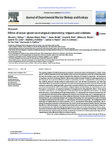Effects of ocean sprawl on ecological connectivity: impacts and solutions
| dc.contributor.author | Bishop, MJ | |
| dc.contributor.author | Mayer-Pinto, M | |
| dc.contributor.author | Airoldi, L | |
| dc.contributor.author | Firth, Louise | |
| dc.contributor.author | Morris, RL | |
| dc.contributor.author | Loke, LHL | |
| dc.contributor.author | Hawkins, SJ | |
| dc.contributor.author | Naylor, LA | |
| dc.contributor.author | Coleman, RA | |
| dc.contributor.author | Chee, SY | |
| dc.contributor.author | Dafforn, KA | |
| dc.date.accessioned | 2017-08-08T13:12:26Z | |
| dc.date.available | 2017-08-08T13:12:26Z | |
| dc.date.issued | 2017-07 | |
| dc.identifier.issn | 0022-0981 | |
| dc.identifier.issn | 1879-1697 | |
| dc.identifier.uri | http://hdl.handle.net/10026.1/9695 | |
| dc.description.abstract |
The growing number of artificial structures in estuarine, coastal and marine environments is causing “ocean sprawl”. Artificial structures do not only modify marine and coastal ecosystems at the sites of their placement, but may also produce larger-scale impacts through their alteration of ecological connectivity - the movement of organisms, materials and energy between habitat units within seascapes. Despite the growing awareness of the capacity of ocean sprawl to influence ecological connectivity, we lack a comprehensive understanding of how artificial structures modify ecological connectivity in near- and off-shore environments, and when and where their effects on connectivity are greatest. We review the mechanisms by which ocean sprawl may modify ecological connectivity, including trophic connectivity associated with the flow of nutrients and resources. We also review demonstrated, inferred and likely ecological impacts of such changes to connectivity, at scales from genes to ecosystems, and potential strategies of management for mitigating these effects. Ocean sprawl may alter connectivity by: (1) creating barriers to the movement of some organisms and resources - by adding physical barriers or by modifying and fragmenting habitats; (2) introducing new structural material that acts as a conduit for the movement of other organisms or resources across the landscape; and (3) altering trophic connectivity. Changes to connectivity may, in turn, influence the genetic structure and size of populations, the distribution of species, and community structure and ecological functioning. Two main approaches to the assessment of ecological connectivity have been taken: (1) measurement of structural connectivity - the configuration of the landscape and habitat patches and their dynamics; and (2) measurement of functional connectivity - the response of organisms or particles to the landscape. Our review reveals the paucity of studies directly addressing the effects of artificial structures on ecological connectivity in the marine environment, particularly at large spatial and temporal scales. With the ongoing development of estuarine and marine environments, there is a pressing need for additional studies that quantify the effects of ocean sprawl on ecological connectivity. Understanding the mechanisms by which structures modify connectivity is essential if marine spatial planning and eco-engineering are to be effectively utilised to minimise impacts. | |
| dc.format.extent | 7-30 | |
| dc.language | en | |
| dc.language.iso | en | |
| dc.publisher | Elsevier BV | |
| dc.subject | Artificial structure | |
| dc.subject | Coastal engineering | |
| dc.subject | Ecological connectivity | |
| dc.subject | Eco-engineering | |
| dc.subject | Marine spatial planning | |
| dc.subject | Trophic connectivity | |
| dc.title | Effects of ocean sprawl on ecological connectivity: impacts and solutions | |
| dc.type | journal-article | |
| dc.type | Review | |
| dc.type | Journal | |
| plymouth.author-url | https://www.webofscience.com/api/gateway?GWVersion=2&SrcApp=PARTNER_APP&SrcAuth=LinksAMR&KeyUT=WOS:000405046700003&DestLinkType=FullRecord&DestApp=ALL_WOS&UsrCustomerID=11bb513d99f797142bcfeffcc58ea008 | |
| plymouth.volume | 492 | |
| plymouth.publication-status | Published | |
| plymouth.journal | Journal of Experimental Marine Biology and Ecology | |
| dc.identifier.doi | 10.1016/j.jembe.2017.01.021 | |
| plymouth.organisational-group | /Plymouth | |
| plymouth.organisational-group | /Plymouth/Faculty of Science and Engineering | |
| plymouth.organisational-group | /Plymouth/Faculty of Science and Engineering/School of Biological and Marine Sciences | |
| plymouth.organisational-group | /Plymouth/REF 2021 Researchers by UoA | |
| plymouth.organisational-group | /Plymouth/REF 2021 Researchers by UoA/UoA07 Earth Systems and Environmental Sciences | |
| plymouth.organisational-group | /Plymouth/Users by role | |
| plymouth.organisational-group | /Plymouth/Users by role/Academics | |
| dc.identifier.eissn | 1879-1697 | |
| dc.rights.embargoperiod | No embargo | |
| rioxxterms.versionofrecord | 10.1016/j.jembe.2017.01.021 | |
| rioxxterms.licenseref.uri | http://www.rioxx.net/licenses/all-rights-reserved | |
| rioxxterms.type | Journal Article/Review | |
| plymouth.oa-location | http://www.sciencedirect.com/science/article/pii/S0022098117300618?via=ihub |


